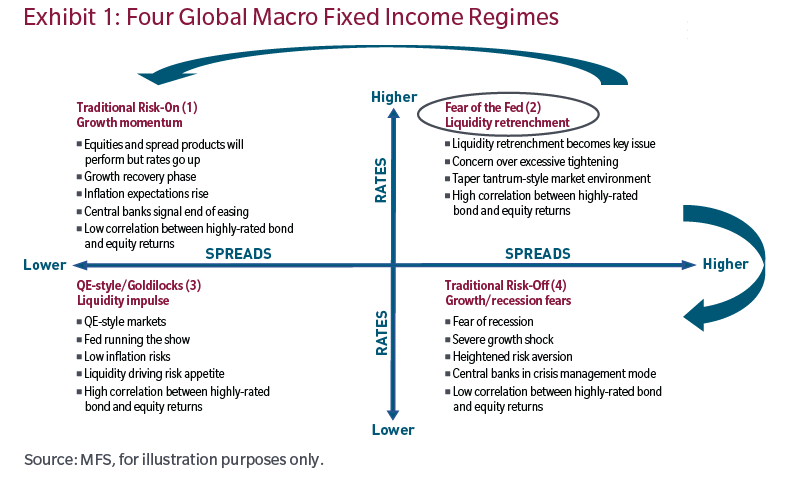Overall, we believe this may be an opportune time to consider increasing allocations to fixed income in anticipation of this positive market paradigm shift.
Endnotes
1 The four-quadrant diagram describes the four possible macro fixed income regimes based on the moves of rates and spreads: the fed of the Fed, growth/recession fears, quantitative easing, and growth momentum. Under the fear of the Fed regime, for instance, both rates and spreads rise. Under the growth fears regime, spreads widen but rates decline.
2 Source: Bloomberg. Short-term correlation is calculated as the 60-day rolling correlation of daily UST and S&P 500 returns. UST = Bloomberg US Treasury index. The data as of 2 June 2023 show a correlation coefficient of -0.48.
3 Bloomberg. ICE BofA Move index is a yield curve weighted index of the normalized implied volatility on 1-month Treasury options. It is the weighted average of volatilities on the CT2, CT5, CT10, and CT30. Data as of 2 June 2023.
4 The BCI incorporates the following variables: Initial jobless claims (Department of Labor), Building permits (US Census Bureau), Philadelphia Fed business outlook survey diffusion index (Philadelphia Fed), New home sales (US Census Bureau), Consumer sentiment index (University of Michigan), Consumer sentiment index Conference Board), Capex expectations index aggregated from the Fed regional surveys (New York, Richmond, Dallas, Kansas City, Philadelphia), ISM new orders (Institute for Supply Management), Corporate profit margin changes (Bureau of Economic Analysis), Corporate profit growth (Bureau of Economic Analysis), Corporate profit margin level (Bureau of Economic Analysis), Output gap (Congressional Budget Office), US Consumer Price Index (Bureau of Labor Statistics), Empire State manufacturing survey (New York Fed), National Association of Home Builders Market Index (NAHB), NFIB Small Business Optimism Index (NFIB), Housing starts (Census bureau), Senior Loan Officer Opinion Survey, Net % of Domestic Respondents Tightening Standards for C&I Loans for Small Firms (Fed), ISM manufacturing (Institute for Supply Management), ISM Services (Institute for Supply Management), Investment ratio: Fixed investment as % of GDP – transformed into monthly series through interpolation (Bureau of Economic Analysis), Compensation Ratio change. Personal Income Compensation of Employees Received as % of GDP. 12-month change in the ratio (Bureau of Economic Analysis), Unit labor cost (Bureau of Labor Statistics).
Source: Bloomberg Index Services Limited. BLOOMBERG® is a trademark and service mark of Bloomberg Finance L.P. and its affi liates (collectively “Bloomberg”). Bloomberg or Bloomberg’s licensors own all proprietary rights in the Bloomberg Indices. Bloomberg neither approves or endorses this material or guarantees the accuracy or completeness of any information herein, or makes any warranty, express or implied, as to the results to be obtained therefrom and, to the maximum extent allowed by law, neither shall have any liability or responsibility for injury or damages arising in connection therewith.
The views expressed are those of the author(s) and are subject to change at any time. These views are for informational purposes only and should not be relied upon as a recommendation to purchase any security or as a solicitation or investment advice. No forecasts can be guaranteed.







